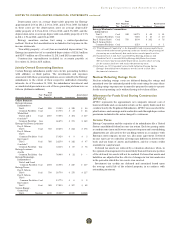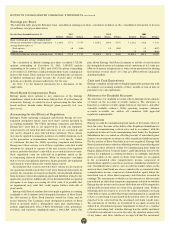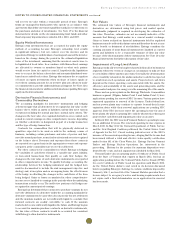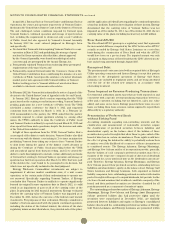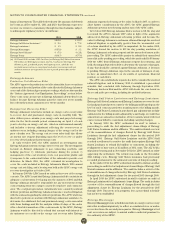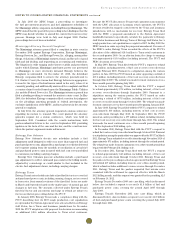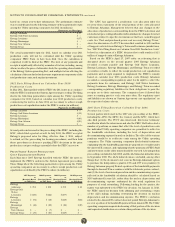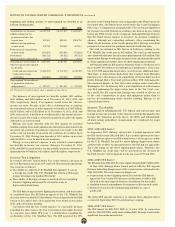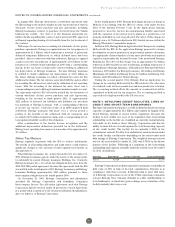Entergy 2011 Annual Report Download - page 75
Download and view the complete annual report
Please find page 75 of the 2011 Entergy annual report below. You can navigate through the pages in the report by either clicking on the pages listed below, or by using the keyword search tool below to find specific information within the annual report.
Entergy Corporation and Subsidiaries 2011
equity based on an adjusted June 2011 test year. The rate case also
proposed a purchased power recovery rider. The parties have agreed
to a procedural schedule that contemplates a final decision by July 30,
2012, with rates relating back to June 30, 3012. On January 12, 2012, the
PUCT voted not to address the purchased power recovery rider in the
current rate case, but the PUCT voted to set a baseline in the rate case
proceeding that would be applicable if a purchased power capacity
rider is approved in separate proceeding.
System Agreement Cost Equalization Proceedings
The Utility operating companies historically have engaged in the
coordinated planning, construction, and operation of generating
and bulk transmission facilities under the terms of the System
Agreement, which is a rate schedule that has been approved by the
FERC. Certain of the Utility operating companies’ retail regulators
and other parties are pursuing litigation involving the System
Agreement at the FERC. The proceedings include challenges to
the allocation of costs as defined by the System Agreement and
allegations of imprudence by the Utility operating companies in their
execution of their obligations under the System Agreement.
In June 2005, the FERC issued a decision in System Agreement
litigation that had been commenced by the LPSC, and essentially
affirmed its decision in a December 2005 order on rehearing. The
FERC decision concluded, among other things, that:
n The System Agreement no longer roughly equalizes total
production costs among the Utility operating companies.
n In order to reach rough production cost equalization, the FERC
imposed a bandwidth remedy by which each company’s total
annual production costs will have to be within +/- 11% of Entergy
System average total annual production costs.
n In calculating the production costs for this purpose under the
FERC’s order, output from the Vidalia hydroelectric power plant
will not reflect the actual Vidalia price for the year but is priced
at that year’s average price paid by Entergy Louisiana for the
exchange of electric energy under Service Schedule MSS-3 of the
System Agreement, thereby reducing the amount of Vidalia costs
reflected in the comparison of the Utility operating companies’
total production costs.
n The remedy ordered by FERC in 2005 required no refunds and
became effective based on calendar year 2006 production costs
and the first reallocation payments were made in 2007.
The FERC’s decision reallocates total production costs of the Utility
operating companies whose relative total production costs expressed as
a percentage of Entergy System average production costs are outside an
upper or lower bandwidth. Under the current circumstances, this will
be accomplished by payments from Utility operating companies whose
production costs are more than 11% below Entergy System average
production costs to Utility operating companies whose production
costs are more than the Entergy System average production cost, with
payments going first to those Utility operating companies whose total
production costs are farthest above the Entergy System average.
Assessing the potential effects of the FERC’s decision requires
assumptions regarding the future total production cost of each Utility
operating company, which assumptions include the mix of solid fuel
and gas-fired generation available to each company and the costs of
natural gas and purchased power. Entergy Louisiana, Entergy Gulf
States Louisiana, Entergy Texas, and Entergy Mississippi are more
dependent upon gas-fired generation sources than Entergy Arkansas
or Entergy New Orleans. Of these, Entergy Arkansas is the least
dependent upon gas-fired generation sources. Therefore, increases in
natural gas prices likely will increase the amount by which Entergy
Arkansas’s total production costs are below the Entergy System
average production costs.
The LPSC, APSC, MPSC, and the Arkansas Electric Energy Consumers
appealed the FERC’s decision to the United States Court of Appeals for
the D.C. Circuit. Entergy and the City of New Orleans intervened in the
various appeals. The D.C. Circuit issued its decision in April 2008. The
D.C. Circuit concluded that the FERC’s orders had failed to adequately
explain both its conclusion that it was prohibited from ordering refunds
for the 20-month period from September 13, 2001 - May 2, 2003 and its
determination to implement the bandwidth remedy commencing on
January 1, 2006, rather than June 1, 2005. The D.C. Circuit remanded the
case to FERC for further proceedings on these issues.
On October 20, 2011, the FERC issued an order addressing the
D.C. Circuit remand on these two issues. On the first issue, the
FERC concluded that it did have the authority to order refunds,
but decided that it would exercise its equitable discretion and not
require refunds for the 20-month period from September 13, 2001
- May 2, 2003. Because the ruling on refunds relied on findings in
the interruptible load proceeding that is discussed below, the FERC
concluded that the refund ruling will be held in abeyance pending the
outcome of the rehearing requests in that proceeding. On the second
issue, the FERC reversed its prior decision and ordered that the
prospective bandwidth remedy begin on June 1, 2005 (the date of its
initial order in the proceeding) rather than January 1, 2006, as it had
previously ordered. Pursuant to the October 20, 2011 order, Entergy
was required to calculate the additional bandwidth payments for
the period June - December 2005 utilizing the bandwidth formula
tariff prescribed by the FERC that was filed in a December 2006
compliance filing and accepted by the FERC in an April 2007 order.
As is the case with bandwidth remedy payments, these payments
and receipts will ultimately be paid by Utility operating company
customers to other Utility operating company customers.
In December 2011, Entergy filed with the FERC its compliance
filing that provides the payments and receipts among the Utility
operating companies pursuant to the FERC’s October 2011 order.
The filing shows the following payments/receipts among the Utility
operating companies (in millions):
Payments or (Receipts)
Entergy Arkansas $156
Entergy Gulf States Louisiana $(75)
Entergy Louisiana $ –
Entergy Mississippi $(33)
Entergy New Orleans $ (5)
Entergy Texas $(43)
Entergy Arkansas made its payment in January 2012. In February 2012,
Entergy Arkansas filed for an interim adjustment to its production cost
allocation rider requesting that the $156 million payment be collected
from customers over the 22-month period from March 2012 through
December 2013. On February 27, 2012, the APSC staff responded to
Entergy Arkansas’s filing and requested that the APSC: 1) determine
whether Entergy Arkansas must make a request separate from the
production cost allocation rider to ask for recovery of the payment
and 2) find that Arkansas law does not allow retroactive ratemaking
and not permit recovery of the payment from customers through the
production cost allocation rider. In the alternative the APSC staff
requested that the APSC determine that an interim production cost
allocation rider rate does not become effective without an APSC order.
The LPSC and the APSC have requested rehearing of the FERC’s
October 2011 order. The APSC, LPSC, the PUCT, and other parties
intervened in the December 2011 compliance filing proceeding, and
the APSC and the LPSC also filed protests.
CALENDAR YEAR 2011 PRODUCTION COSTS
The liabilities and assets for the preliminary estimate of the payments
and receipts required to implement the FERC’s remedy based on
calendar year 2011 production costs were recorded in December 2011,
NOTES TO CONSOLIDATED FINANCIAL STATEMENTS continued
73


